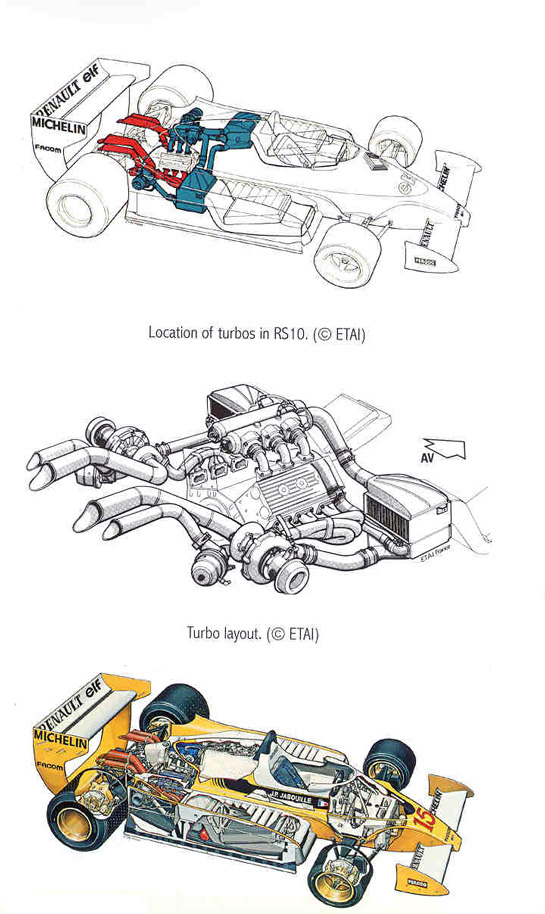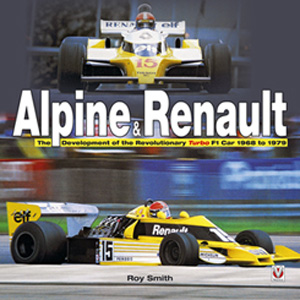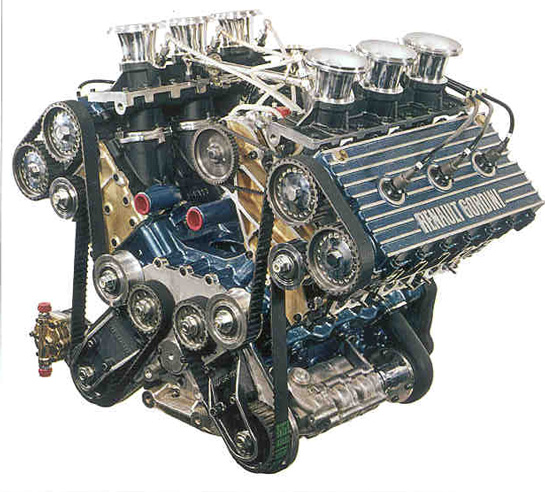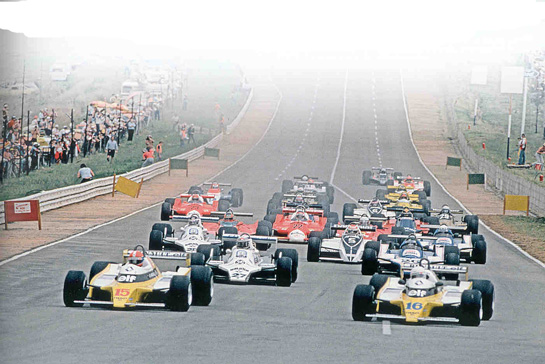Review by Pete Vack
Images courtesy of Veloce Publishing
VelocePublishing 2008
By Roy Smith
Roy Smith has made good use of his automotive and professional experience, (Read “Roy Smith, A good go”) putting both to work in order to get his hands around a very complex, difficult and many layered history. On one level to write “Alpine and Renault, The Development of the Revolutionary Turbo F1 Car 1968 to 1979,” seems a simple task; one car, one era, one manufacturer, one formula.
But in reality, Smith is faced with the convergence of three car manufacturers and one hungry-for-publicity oil company, and the story, which involves sports car racing, rallying, Formula 3 and sports prototypes, begins in the early 1950s. Smith gives us a brief history of Renault, and mentions that Louis Renault had patented a type of turbocharged engine before WWI. Then, an even more in depth look at the work of Jean Rédélé at Alpine; how he made use of fiberglass and good designers (Michelotti) to create a true post war French sports car based on the 4CV and built on this to eventually win the World Rally Championship in 1973. Alpine longed to be accepted by mother Renault; and eventually was.
Another elemental chapter concerns Amédée Gordini, who also looked to Renault for acceptance but in the end, was not sure if he liked the deal he made. By 1969 Renault had bought 70 percent of Gordini after the V8 engine failures at LeMans in that year, and put the old man out to pasture. Gordini’s name would remain a marketing tool and cast into the cam covers of the 2 liter V6 designed by the team of Francois Castaing in 1975. This engine would provide the basis for the turbo Renault F1, and sports racing engines.
Please take the time to contribute and keep VeloceToday coming to your inbox every week. It’s easy and safe. Simply click here for details. 
Smith covers this in a very detailed chapter, and leads on to the side by side development of the Alpine A500, the prototype semi monocoque Formula car designed by the team headed by Andre de Cortanze. The A500 successfully tested new Michelin radial racing tires and the turbo 1500. By the end of 1976, Renault had its first F1 car, the RS01. On July 1, 1979 at Dijon France, the turbo-charged Renault Elf won its first Grand Prix, with Jabouille driving. It was a historic moment for Renault, France, and the beginning of the fascinating era of turbocharged F1 cars.
After a detailed history and description of the development of the V6 Turbo and chassis, Smith tracks F1 race results from the Renault perspective from 1977 to 1979 and follows up through 1985 with plenty of technical insights between the chapters on the races. It is generally in chronological order, but often seems in chaotic–as we said, this is a difficult topic to manage and Smith has done a superb job and does so in a mere 235 pages. Since this is largely a post 1955 history, 99 percent of the photos are in color and extremely relevant to the text. The captions, however, are slight, perhaps too slight. Another criticism is that although there is an index, there is no bibliography, no footnotes. There is a well done acknowledgement section in the Introduction.
In addition to the drivers and designers, Smith involves the company managers and Public Relations men who were very much a part of the building blocks of the Renault Sport (to be headed by Gerald Larrousse). Nor does Smith shy from the technical aspects of Formula One, with full descriptions of the Alpine A350 F1 car which debuted a ‘flat’ suspension, and a full chapter on the technical aspects of the turbocharged Renault Gordini F1 engine.
Smith has personally interviewed many of the original participants, making this a wealth of first person accounts of an era gone by. The interviews, comments and illustrations provided by the participants make the book; there is no guessing, no assumptions, but clear and concise comments from those who did the actual work. A list of the subjects at hand is thoroughly impressive: Chassis designer Richard Bouleau, driver Mauro Bianchi, Alpine manager Jacques Cheinisse, Henri Cauchet, Francois Castaing, Jean Pierre Boudy, Bernard Dudot, Francois Guiter, Jean Sage, Gerard Larrousse and Jean Pierre Jabouille is a partial list of actual interviewees. The main subjects are very well aware of Smith’s efforts and four contributed to the Foreward; drivers Jabouille and Bianchi, engineer Bernard Dudot, and Elf manager Francois Guiter, who in many respects was the key to building the team responsible for Renault’s successes in Formula One.
It should be apparent that this is a must have for students of Formula 1, French race cars, Alpine, Gordini and Renault. A huge gap, filled.



While looking at my bookshelf I discovered “L’Album Williams Renault de la Formule 1”, new, sealed in plastic. It has no ISBN or barcode as it was produced by Renault as an advertising item (I think).
Dimensions are 11? ” x 8¾” x ?” (29 x 22,5 x 9mm). It is a hardcover and probably has no more than 100 pages, printed in French (of course). It is obviously a review of the Williams Renault F-1 history & victories before they left F-1. Have no idea of value but if interested, send an email to the editor.
Ted
Send a reply to pete@velocetoday.com if interested